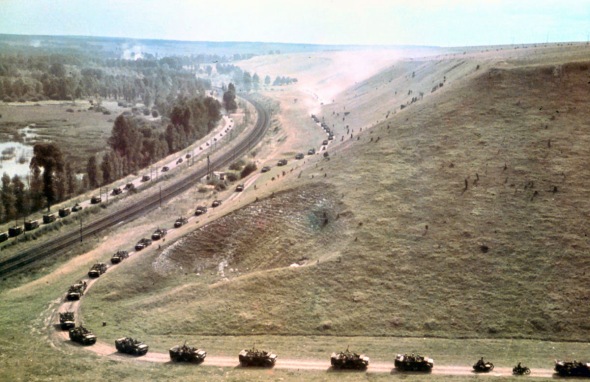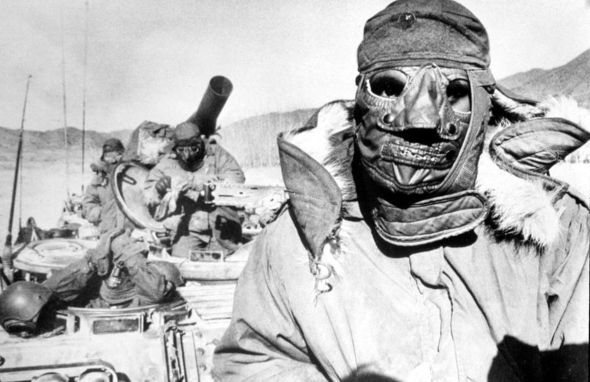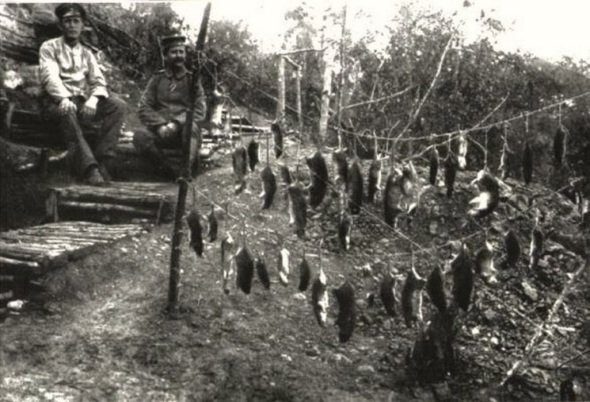“The Mine Test” – Wehrmacht Soldiers Force a Soviet Civilian to Test the Waters, Soviet Union; ca.1942
According to historian Christian Ingrao this technique was first used in Belarussia in 1943 by the infamous 36th SS division “Dirlewanger”, a penal SS unit composed of common law criminals, disgraced SS soldiers, poachers, feeble minded, sociopaths and pedophiles recruited among the inmates of concentration camps and used to hunt partisans in the East.
After they began losing men to mined roads, they took the habit of rounding up local villagers and make them march before them in staggered rows. The tactic was deemed very effective by SS Gruppenfuhrer for Central Russia Curt Von Gottberg who wrote a report on the practice in 1943 saying “The mines set on most road and paths necessitated the use of mine detectors, as per order. The mine detector developped by the Dirlewanger battalion successfully passed the test”. Soon after various non-penal units began using it too. Believe it or not it is far from the worst thing these guys did.
The archives of the 36th SS division stated that this practiced caused the death of about 3000 Belarussian civilians for year 1943 alone.
Original title from the back of the photograph is Die Minenprobe:
American POW Paul Galanti unobtrusively gives the finger, to show his disdain for being used in a propaganda event filmed by an East German film crew in North Vietnam; ca. June 1967
After graduating from the U.S. Naval Academy in 1962, then-ENS Galanti reported to fighter jet training, learning to fly the A-4C Skyhawk. In November 1965, he deployed on the carrier USS Hancock to South East Asia. On his 98th combat mission in Vietnam, he was shot down and captured by the North Vietnamese. He spent almost seven years, from 17 June 1966 to 12 February 1973, interned in the infamous Vietnamese prison camp dubbed the “Hanoi Hilton.”
American prisoners of war have long been used as propaganda tools by the enemy — a weapon of war that has sometimes met with success, but has just as often left the enemy looking dim-witted and brutal.
When an East German camera crew arrived at his cell Navy Commander Paul Galanti was ordered to pose for photos.
A stencilled sign reading “Clean, Neat” had been painted on his wall and a makeshift bench, a luxury he did not normally have, was brought in.
“My interrogators wanted me to be interviewed by them and I said I’d be glad to speak with them because I speak German and I’d tell them all about the torture and bad treatment. They came back and said I was not to say anything to them,” Mr. Galanti said from his home in Richmond, Va., yesterday.
The captured aviator had no intention of being a propaganda tool for the enemy. As he sat with his hands resting between his knees he stared into the camera and had a flash of mischievous genius.
“I gave a catcher’s signal with both middle fingers extended and glared at the camera the whole time. I extended my middle finger on each hand to make certain that anybody who saw that picture didn’t think in any way, shape or form that I was doing it voluntarily.
“It was a message from me.”
(Source)
Another picture:
Life Magazine published this image in October, 1967, but airbrushed his middle fingers so as not to offend its readers:
German SS guards, exhausted from their forced labor clearing the bodies of the dead, are allowed a brief rest by British soldiers but are forced to take it by lying face down in one of the empty mass graves; ca. 1945
Taken during the liberation of the Bergen-Belsen concentration camp.
(Source)
There’s a famous quote from BBC journalist Richard Dimbleby, who was present at the liberation of this very camp.
Here over an acre of ground lay dead and dying people. You could not see which was which… The living lay with their heads against the corpses and around them moved the awful, ghostly procession of emaciated, aimless people, with nothing to do and with no hope of life, unable to move out of your way, unable to look at the terrible sights around them … Babies had been born here, tiny wizened things that could not live … A mother, driven mad, screamed at a British sentry to give her milk for her child, and thrust the tiny mite into his arms, then ran off, crying terribly. He opened the bundle and found the baby had been dead for days.
This day at Belsen was the most horrible of my life
Rudolph Hoss, the Commandant of Auschwitz, trying to avoid the noose, before being hanged on the grounds of Auschwitz; April 16, 1947
Höss introduced pesticide Zyklon B containing hydrogen cyanide to the killing process, thereby allowing soldiers at Auschwitz to murder 2,000 people every hour. He created the largest installation for the continuous annihilation of human beings ever known.
Nineteen year old Robert Wadlow (height 8 ft 7 in) the tallest person in recorded history, chatting with a friend after appearing at a charity event in Omaha, Nebraska; April 1, 1937
Robert Pershing Wadlow (February 22, 1918 – July 15, 1940) also known as the Alton Giant and the Giant of Illinois, is the tallest person in recorded history for whom there is irrefutable evidence. The Alton and Illinois monikers reflect the fact that he was born and grew up in Alton, Illinois.
Wadlow reached 8 ft 11.1 in (2.72 m) in height and weighed 439 lb (199 kg) at his death at age 22. His great size and his continued growth in adulthood were due to hyperplasia of his pituitary gland, which results in an abnormally high level of human growth hormone. He showed no indication of an end to his growth even at the time of his death. (Wikipedia)
Robert Wadlow with his family:
Five months before his death, an image of Robert Wadlow, taken February 23, 1940, in a St. Petersburg, FL, hotel lobby:
Pathe newsreel from 1935, when he was just 8′ 4″:
Edda Göring and her mother, Emmy Göring, receive a handwritten letter from Hermann Göring in his death cell at Nürnberg; September 26th, 1946
 Edda is the only daughter of Reichsmarschall Hermann Göring and Emmy Göring. Before married, Emmy (birth name Emma Johanna Henny Sonnemann) had been an actress. After marrying Göring in 10 April 1935, she became Germany’s first lady, since Hitler had no wife at the time. Emmy Göring was a genuinely gracious woman with a naive charm. Edda was born in 2 June 1938 and grew up in Berlin.
Edda is the only daughter of Reichsmarschall Hermann Göring and Emmy Göring. Before married, Emmy (birth name Emma Johanna Henny Sonnemann) had been an actress. After marrying Göring in 10 April 1935, she became Germany’s first lady, since Hitler had no wife at the time. Emmy Göring was a genuinely gracious woman with a naive charm. Edda was born in 2 June 1938 and grew up in Berlin.
This photograph of Edda and Emmy was taken in Nürnberg on 26 September 1946, during the war crimes trial. Nineteen days later, Hermann Göring took his own life a day before his scheduled execution. At that time Edda was eight years old. After the trial Edda and her mother spent four years in an Allied prison camp. Years later, her mother would say it was the hardest time of their lives. After being released they lived in Münich.
Emmy died in 1973. In 1991 Gerald Posner published some quotes from Edda in his book “Hitler’s Children”. Edda complained that after the war “the government was terrible. They didn’t even let me keep [my father’s] wartime medals. The Americans stole his special baton.” Edda was very much anti-America and probably blamed America in particular for her father’s death. She rejected the overwhelming evidence that her father was involved with the war crimes.
In Posner’s book Edda was quoted as saying, “My only memories of him are such loving ones, I cannot see him any other way. I actually expect that most everybody has a favorable opinion of my father, except maybe in America. He was a good father to me.”
A group of Lithuanians attempt to stop a Soviet tank from crushing a fellow protester during the assault on the television station in Vilnius; January 13th, 1991
At least 13 people have been killed and more than 140 injured by the Soviet military in the capital of Lithuania as Moscow continues its crackdown on the Baltic republic and its drive for independence.
Troops broke through the defences set up by more than 1,000 protesters who had gathered to protect a Lithuanian radio and television centre at about 0200 local time.
Soldiers then smashed through the glass windows of the station and overwhelmed defenders armed with sticks.
The broadcast facility was one of several buildings seized by Soviet troops in Vilnius since they began cracking down on 11 January. Yesterday, tanks ploughed into unarmed demonstrators in Vilnius before soldiers opened fire on a crowd attempting to defend a government building.
The assault represents a major escalation in the Soviet Government’s use of force against the republic.
It is the bloodiest military attack on peaceful citizens since troops killed nine nationalist demonstrators in Georgia in 1989. (BBC)
Original caption: A group of Lithuanians attempt to stop a Soviet Red Army tank from crushing a fellow protester during the assault on the Lithuanian Radio and Television station early 13 January 1991 in Vilnius. Soviet troops opened fire on unarmed civilians in Vilnius, killing 13 people and injuring 100 others. Lithuania declared unilaterally its independence from Soviet Union 11 March 1990.
Afro-German soldier of the Nazi Germany – Free Arabian Legion; ca. September 1943
The Free Arabian Legion provided an opportunity for German blacks who wanted to fight for the Reich. The unit’s founder was Haj Amin Al Husseini, an anti-Semite Muslim.
The Legion included Arab volunteers from the Middle East and North Africa, war prisoners who opted to fight instead of go to prison … and blacks. In the end, the Legion saw very little combat action—and most of that during the Allies’ Operation Torch in French North Africa.
Nazi racial ideology in practice could be very inconsistent:
- 57% of Soviet prisoners and millions of Soviet civilians die as a result of intentional Nazi policy. But a Russian volunteer battallion is raised to fight for Nazi Germany
- Several groups of Africans fighting for France are murdered upon capture by German troops. But some African volunteers are enlisted in the German armed forces
- Ethnic Germans in Poland are deemed superior to Poles. But these ethnic Germans, when found guilty of rape, are punished and declared as not being like “true” German men
- Non-white colonial POWs who fought for France are treated badly and suffer worse mortality rates than white French POWs. But yet the Germans collaborate with certain groups of non-whites.
A little Russian girl touches her dead mother just after the liberation of the Ozarichi concentration camp in Belarus; ca. March 1944
Information on the liberation of the Ozarichi death camps.
Crater from the “Sedan” underground nuclear test as part of Operation Plowshare in Nevada. The 104 kiloton blast displaced 12 million tons of earth and created a crater 320 feet deep and 1,280 feet wide; ca. 1962
There’s an urban legend that says that this blast is responsible for John Wayne’s death (and most of the film crew) due to cancer:
Of the 220 persons who worked on The Conqueror on location in Utah in 1955, 91 had contracted cancer as of the early 1980s and 46 died of it, including stars John Wayne, Susan Hayward, and Agnes Moorehead, and director Dick Powell. Experts say under ordinary circumstances only 30 people out of a group of that size should have gotten cancer. The cause? No one can say for sure, but many attribute the cancers to radioactive fallout from U.S. atom bomb tests in nearby Nevada.
The Conqueror, a putative love story involving Genghis Khan’s lust for the beautiful princess Bortai (Hayward), was a classic Hollywood big budget fiasco, one of many financed by would-be movie mogul Howard Hughes. Originally director Powell wanted to get Marlon Brando for the lead, but John Wayne, then at the height of his popularity, happened to see the script one day and decided he and Genghis were meant for each other. Unfortunately, the script was written in a cornball style that was made even more ludicrous by the Duke’s wooden line readings. In the following sample, Wayne/Genghis has just been urged by his sidekick Jamuga not to attack the caravan carrying Princess Bortai: “There are moments fer wisdom, Juh-mooga, then I listen to you–and there are moments fer action — then I listen to my blood. I feel this Tartar wuh-man is fer me, and my blood says, ‘TAKE HER!'” In the words of one writer, it was the world’s “most improbable piece of casting unless Mickey Rooney were to play Jesus in The King of Kings.”
The movie was shot in the canyonlands around the Utah town of St. George. Filming was chaotic. The actors suffered in 120 degree heat, a black panther attempted to take a bite out of Susan Hayward, and a flash flood at one point just missed wiping out everybody. But the worst didn’t become apparent until long afterward. In 1953, the military had tested 11 atomic bombs at Yucca Flats, Nevada, which resulted in immense clouds of fallout floating downwind. Much of the deadly dust funneled into Snow Canyon, Utah, where a lot of The Conqueror was shot. The actors and crew were exposed to the stuff for 13 weeks, no doubt inhaling a fair amount of it in the process, and Hughes later shipped 60 tons of hot dirt back to Hollywood to use on a set for retakes, thus making things even worse.
Many people involved in the production knew about the radiation (there’s a picture of Wayne himself operating a Geiger counter during the filming), but no one took the threat seriously at the time. Thirty years later, however, half the residents of St. George had contracted cancer, and veterans of the production began to realize they were in trouble. Actor Pedro Armendariz developed cancer of the kidney only four years after the movie was completed, and later shot himself when he learned his condition was terminal.
Howard Hughes was said to have felt “guilty as hell” about the whole affair, although as far as I can tell it never occurred to anyone to sue him. For various reasons he withdrew The Conqueror from circulation, and for years thereafter the only person who saw it was Hughes himself, who screened it night after night during his paranoid last years.
(Source)
Adolf Hitler salutes a parade of his personal bodyguard regiment, the 1st SS Division Leibstandarte SS Adolf Hitler; January 30th,1937
Mechanized Column of the 7th Panzer-Division in France; ca. 1940

Shown here is a mechanized column of the 7th Panzer-Division, commanded by General major Erwin Rommel, on the move during the Blitzkrieg through France in the last days of May 1940. The photo was taken by General Rommel himself.
Skulls left lying on the battlefield after the Battle of the Wilderness – American Civil War; ca. 1864
Hungarian Jewish children and an elderly woman on the way to the death barracks of Auschwitz-Birkenau, ca. May 1944
“From the chimneys of the Vatican, white smoke rises,
a sign the Cardinals have chosen themselves a Pope.
From the crematoria of Auschwitz, black smoke rises,
a sign the conclave of Gods hasn’t yet chosen,
the Chosen People.
After Auschwitz, no theology:
the inmates of extermination bear on their forearms
the telephone numbers of God,
numbers that do not answer
and now are disconnected, one by one.
After Auschwitz, a new theology:
the Jews who died in the Shoah
have now come to be like their God,
who has no likeness of a body and has no body.
They have no likeness of a body and they have no body.”
– Smoke by Jacob Glatstein




























